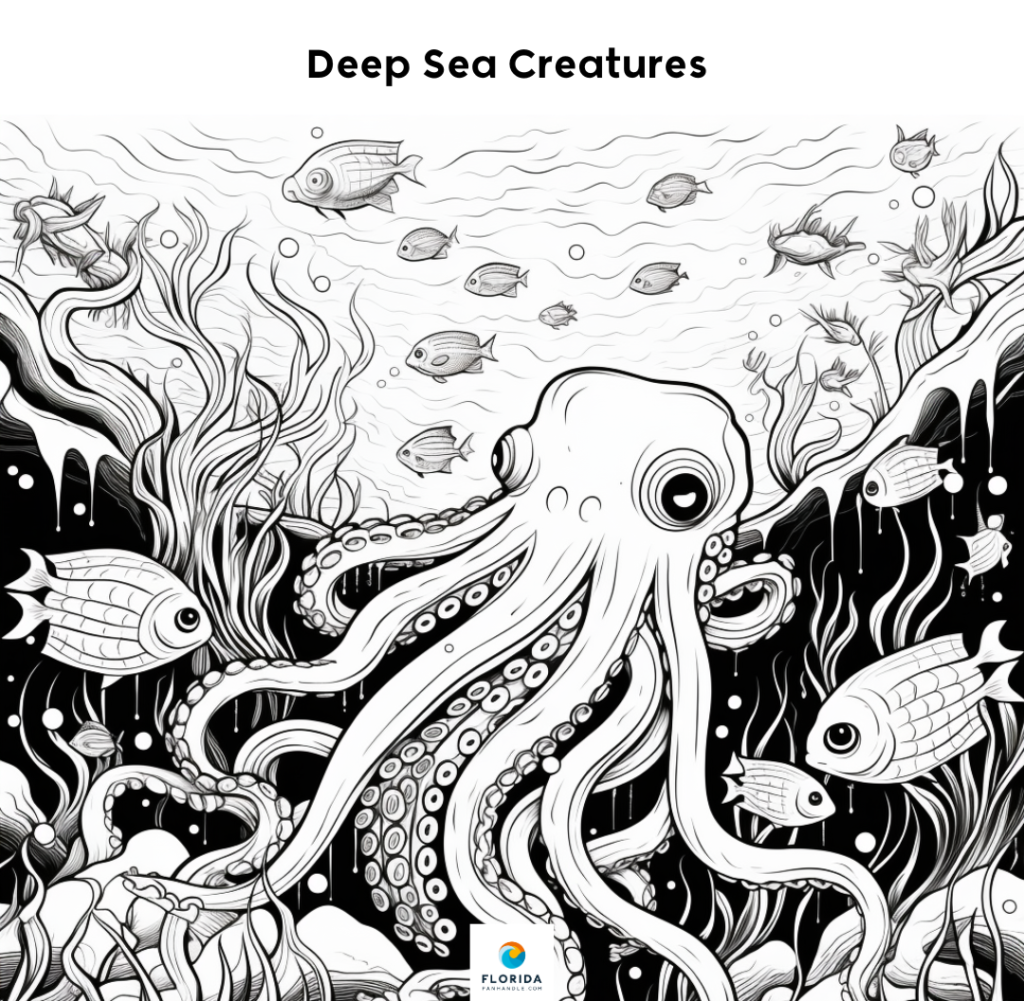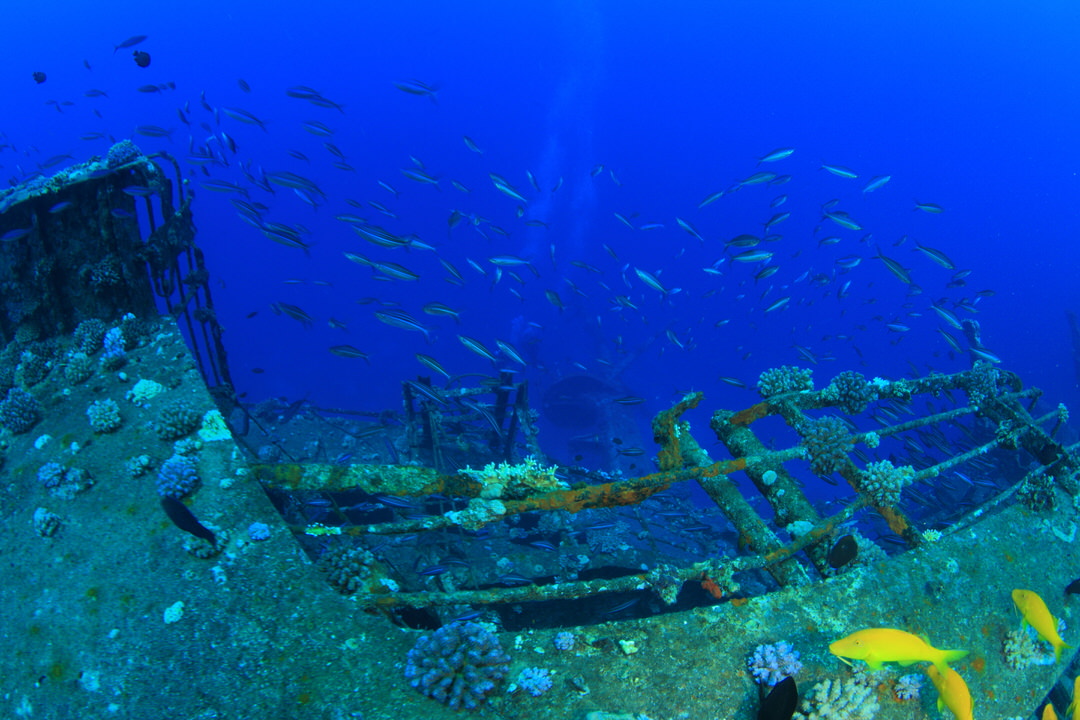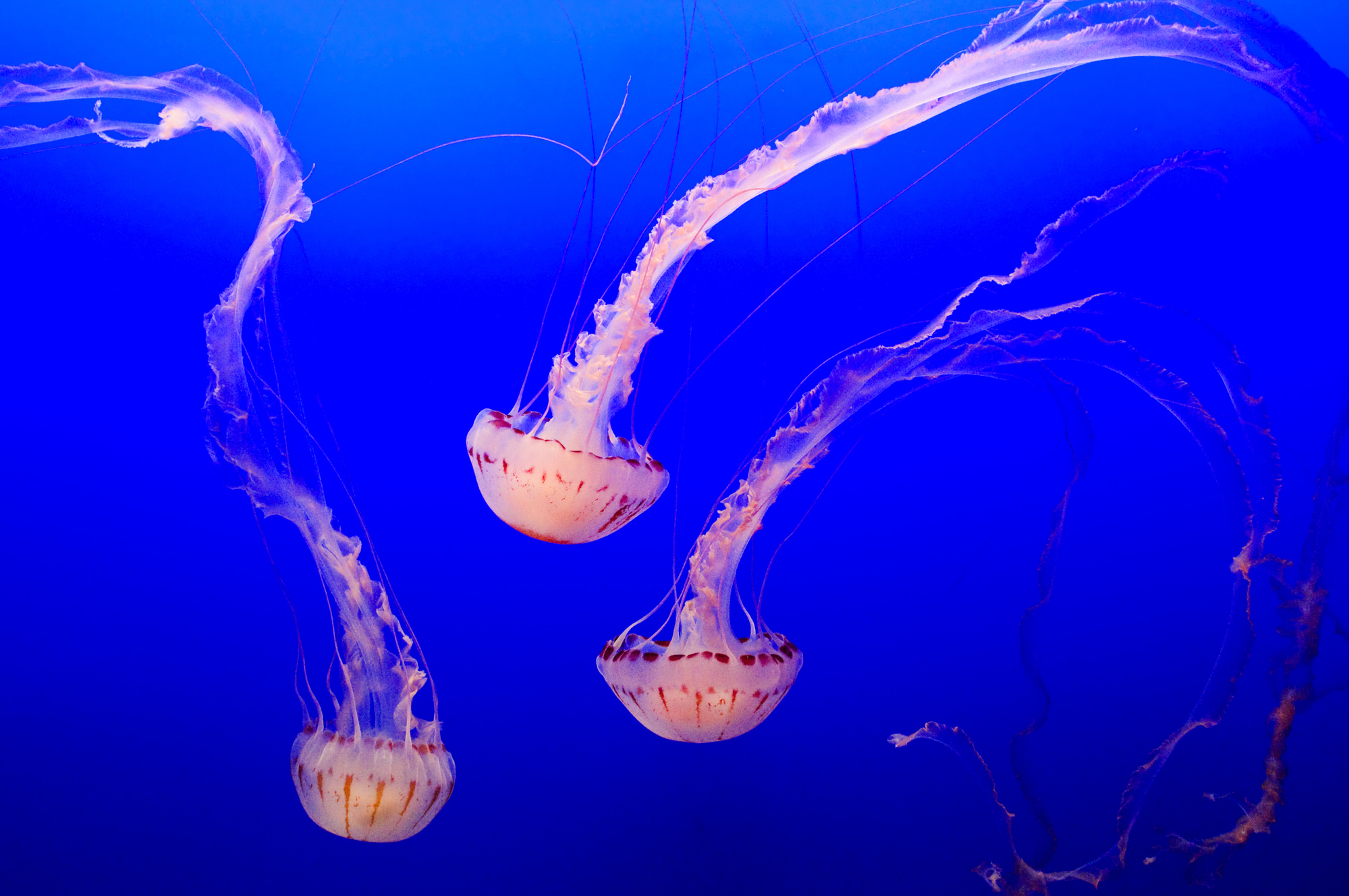It’s often said that we know more about the surface of the Moon than the depths of our planet’s oceans, which is astounding when you consider that saltwater realm stands as the most extensive feature on Earth.
About 97 percent of all the planet’s water—which constitutes a part of the Earth system known as the Hydrosphere—resides in the World Ocean. (The arrangement of Earth’s continents, plus some arbitrary political boundaries, help define individual ocean basins—the Pacific, the Atlantic, the Arctic, etc.—but all are interconnected, and thus fundamentally, we’re dealing with one great oceanscape: hence “World Ocean.”) And this mighty saltwater realm covers a whopping 71 percent of our globe. In other words, Earth is definitely more ocean planet than terra firma planet!
In this guide, we’ll explore the World Ocean anchored by a tying-together interest in just how deep it is, and how its incredible depth influences the structure and extent of its ecosystems—and inspires the human drive for exploration.
How We Conducted This Study
We analyzed official data from the National Oceanic and Atmospheric Administration (NOAA), including basic information on ocean depth and zonation with some relevant statistics and histories regarding the marine heritage of humanity, from underwater recreation and exploration to some notable shipwrecks and submarine wrecks.
Key Findings
- The average depth of the World Ocean is about 12,200 feet (3,730 meters). That accounts for much of the seafloor, as formed by what oceanographers call the abyssal plain.
- In places, the seafloor plunges to much greater depths in the oceanic trenches marking subduction zones between tectonic plates. The deepest of all the oceanic trenches is the Mariana Trench of the Pacific Ocean, which harbors the greatest “deep” of the World Ocean: the Challenger Deep, a staggering 36,201 feet (11,034 meters) below the surface.
- The stature of Earth’s tallest mountain, 29,031-foot Mount Everest, is often used to visualize the depth of the Challenger Deep: You could nestle Mount Everest within it, and there’d still be more than a mile of seawater above the summit!
The Pacific Ocean is the Deepest of the Ocean Basins
Covering about 64 million square miles—close to half of the area of Planet Earth—the Pacific Ocean is by far the largest basin of the World Ocean. As we’ve already explained, it’s also the deepest ocean basin: It has an average depth of 14,040 feet (4,280 meters), and, again, reaches 36,201 feet in the Challenger Deep.
The next-deepest basin is the roughly 41.1-million-square-mile Atlantic Ocean, which has an average depth of 12,881 feet (3,926 meters)—not counting its marginal seas such as the Mediterranean and Caribbean—and a maximum depth of 28,232 feet (8,605 meters), attained in the Milwaukee/Brownson Deep of the Puerto Rico Trench (which lies along the boundary of the Caribbean Sea and open Atlantic).
The Indian Ocean, which sprawls across nearly 28 million square miles, has an average depth of 12,274 feet (3,741 meters) and a maximum depth of 24,442 feet (7,450 meters) at the bottom of the Sunda (aka Java) Trench.
The Southern Ocean encompasses that vast band of unobstructed (and chilly!) waters encircling Antarctica, which accounts for about eight million square miles. Occasionally also referred to as the Antarctic Ocean, the Southern Ocean is an average of 10,728 feet (3,270 meters) deep and reaches maximum depth in the “Factorian Deep” (an unofficial name) of the South Sandwich Trench: 24,388 feet (7,434 meters).
Finally, the smallest and shallowest of the ocean basins is the 5.42-million-square-mile Arctic Ocean, which averages “only” 3,420 feet (987 meters) deep. In the Molloy Deep off Greenland, however, the Arctic Ocean plunges to 18,210 feet (5,550 meters).
As You Go Deeper, the Ocean Gets Colder… and Eerily Darker

Given just how much of the planet is covered by the ocean, and the mind-boggling span from surface to seafloor, it’s no surprise scientists have divvied up this grandest ecosystem of all into various zones.
There are many ways to section off the ocean—by physical characteristics, by ecological community, by geography—so certain zones overlap with one another, and, as we’ve demonstrated, the different marine basins differ significantly in extent, depth, and position, which influences their zonation.
But given that we’re most interested in ocean depth here, we’ll keep things pretty simple here and mostly stick to the basic vertical zones of the open ocean. We should, however, talk “horizontally” for a moment: By open ocean, we mean the oceanic zone, which covers the ocean beyond the continental shelves that slope down from the coastlines. Nearshore and continental-shelf waters are classified as the neritic zone.
Most basically, the vertical extent of the ocean can be divided between the pelagic zone, which encompasses most of the water column, and the benthic zone, describing the seafloor and the waters immediately above it.
The following breakdown, though, is a more fine-tuned classification of ocean zones defined by depth and the penetration of sunlight. We’ll structure these most broadly based on light penetration into three main zones, then further subdivide those to better orient ourselves to the deep ocean.
Euphotic Zone: A Sunny Disposition
The euphotic zone (surface to 656 feet or 200 meters) is also called the sunlight (or sunlit) zone or the epipelagic zone, and as the first of those alternate names suggests, this is the uppermost and most light-filled section of the ocean. That said, most of the visible light is absorbed in the upper 300 or so feet.
The euphotic zone is the warmest of the ocean zones and its temperature is overall pretty evenly distributed thanks to well-mixed waters (due to the influence of wind). But the temperature range of the euphotic zone across the World Ocean is broad: coldest in polar regions, warmest in equatorial regions—from about 28 degrees Fahrenheit at the North Pole to nearly 100 degrees Fahrenheit in the low-latitude, sun-blasted Persian Gulf.
The abundant sunlight fuels photosynthesis in the euphotic zone, which hosts most of the ocean’s primary production via phytoplankton and macroalgae. Consequently there’s a large biomass and rich diversity of sealife, from those little planktonic organisms to the biggest creatures in the world (the great whales), though many animals spending large portions of their time in the euphotic zone may venture deeper on a regular or sporadic basis. Some, however, such as the varied communities of surface-floating, or neustonic, organisms (such as sargassum weed and by-the-wind sailors) are entirely restricted to the sunlight zone.
Disphotic Zone: The Middle Child
Below the sunlight zone lies the disphotic zone (656 to 3,280 feet or 200 to 1,000 meters), also known as the mesopelagic, midwater, or twilight zone (no, not the show!). This is generally considered the upper layer of the deep ocean, which accounts for the vast majority of the marine world. Sunlight does minimally penetrate into this realm, fading with depth, but overall it’s a dim, shrouded environment—basically eternally twilit.
This zone hosts the thermocline, the boundary between the well-mixed, surface-influenced waters and the colder depths across which temperature drops very sharply. (The thermocline rises and lowers across seasons and latitudes; it’s often entirely absent during winter months in polar regions.) Speaking of temperature, it has a significantly lower range in the disphotic zone compared to the sunlight zone above: roughly 39 to 41 degrees Fahrenheit.
Although only a very limited amount of primary production goes on in the disphotic zone, the twilight zone still hosts an impressive amount of biomass. Indeed, research suggests 90 percent of all fish—as well as numerous crustaceans and squids—inhabit this zone. Adaptations to low levels of light are, it won’t surprise you, widespread here: The eyes on mesopelagic fish tend to be larger, for example, than their epipelagic counterparts.
And a variety of sea creatures that spend most of their time closer to the surface will dive down into (and sometimes past) the twilight zone to forage: from large sharks and sea turtles to pinnipeds, whales, and emperor penguins.
Aphotic Zone: A Cold, Dark Abyss
The aphotic zone (below 3,280 feet or 1,000 meters) accounts for all of the deep ocean beyond the reach of sunlight, cast in year-round darkness and cold. The only light to be found in this cold, deep black is generated by sealife, via bioluminescence—or introduced by human submersibles. The aphotic zone includes three major subdivisions: the bathypelagic (midnight) zone, abyssopelagic (abyssal) zone, and hadopelagic (hadal) zone.
The Bathypelagic or Midnight Zone: 3,280 to 13,123 Feet (1,000 to 4,000 Meters)
The upper subdivision is the bathypelagic or midnight zone, which stretches between 3,280 and 13,123 feet (1,000 and 4,000 meters) deep. The little-varying temperature hovers around 39 degrees Fahrenheit.
Pressure increases in the ocean depths by about one atmosphere per 33 feet. It gets downright crushing in the bathypelagic zone: more than 5,850 pounds per square inch at 13,100 feet down. Yet life survives down here, mainly in the form of deep-sea fishes (including bizarre-looking anglerfish, gulper eels, and fangtooths), crustaceans, jellyfish, and cephalopods, ranging from the spike-tentacled vampire squid to the hulking giant and colossal squids. Speaking of hulking, some very big fish can also be found at these depths, including the giant grenadier (which may exceed six feet long) and a number of deep-sea sharks, such as goblin sharks, sixgill sharks, and the various sleeper sharks, which may reach or exceed 20 feet long.
Hotspots of biodiversity in the midnight zone are found at hydrothermal vents, essentially undersea geysers found along mid-ocean ridges that issue superheated, mineral-rich water and support communities of bacteria that can produce energy from the chemicals released by the vents.
The midnight zone is, rather astonishingly, exploited by certain exceptionally deep-diving air-breathing sea creatures. Leatherback turtles, for example—the biggest sea turtles in the world—have been documented deeper than 4,000 feet. Both elephant seals and sperm whales can dive past 7,000 feet deep to hunt; sperm whales famously prey on giant and colossal squids at these great depths, locating their quarry in the endless dark using echolocation. But the champ diver among marine mammals—at least so far as we know—is the Cuvier’s beaked whale, which in its pursuit of deep-sea squid, fish, shrimp, and other prey has been tracked at depths as great as 9,874 feet!
All of these deep-divers exhibit special adaptations to deal with the tremendous pressure of the midnight zone—and the long duration of their visits to it. Leatherback turtles, for example, can collapse their lungs, while the blood of elephant seals and sperm whales comes extra-rich in oxygen-storing myoglobin and oxygen-transporting red blood cells.
The Abyssopelagic or Abyssal Zone: 13,123 to 19,685 Feet (4,000 to 6,000 Meters)
Covering some 115 million square miles—about 60 percent of the globe—the abyssal zone is the largest environment on Earth. It encompasses about three-quarters of the seafloor (much of it as relatively featureless abyssal plains), thus forming the bottom layer of much of the ocean except for the deep-sea trenches. The temperature is a little above freezing (32 degrees Fahrenheit), and the pressure can be 600 times that experienced at sea level.
Comparatively few fish and invertebrates (such as brittle stars, amphipods, and jellyfish), all specially adapted to the cold, dark, and great pressure, inhabit this zone. Because oxygen is very limited right at the abyssal seafloor, benthic organisms here often have stalk-like appendages to elevate them above it. (An example is the aptly named tripod fish.)
Far, far out of reach of sunlight and primary production, the abyssal zone is generally poor in nutrients, and organisms here either feast on organic matter drifting down from above or upon each other. Carcasses of animals sinking to the “abyss” are a hugely important energy source, and none represent more of a boon than those of the great whales (the category including the big baleen whales as well as the sperm whale). A bevy of scavengers attend to these so-called whalefalls, from crabs and shrimp to hagfishes. (Of course, whalefalls are also an ecological phenomenon on shallower seafloors, including in the midnight zone.)
The Halopelagic or Hadal Zone: Below 19,685 Feet (6,000 Meters)
The ocean reaches its very greatest depth in the deep-sea trenches, part of the hadal zone (named after Hades, the Greek god of the underworld). The temperature hovers just above freezing, and the pressure is enormous: more than eight tons per square inch in the deepest trench of all, the Pacific’s Mariana Trench.
Life does survive in the extreme environment of the hadal zone—even in the deepest point of the ocean, the Challenger Deep in the Mariana Trench, where such organisms as single-celled foraminifera, marine worms, and sea cucumbers have been recorded.
The depth record for fish belongs to snailfish, which have been filmed at roughly 26,800 feet in the Mariana Trench; scientists reckon this is indeed about the deepest that fish can survive the enormous pressure of the hadal zone.
Even Our Favorite Recreational Activities Have Limits
Without specialized crafts, humans are basically limited to the euphotic zone when it comes to underwater adventure and recreation. Snorkelers, for example, usually go no deeper than six to 15 feet (1.8 to four meters).
The standard limit for recreational scuba divers is 130 feet (40 meters), at which one experiences pressure five times greater than at the surface. Technical divers with specialized equipment can go deeper; the deepest scuba dive was 1,090 feet (332 meters), achieved by diver Ahmed Gabr in the Red Sea in 2014. (Gabr only needed about 15 minutes to get down that far, but—because of the grave danger posed by decompression sickness (aka “the bends”)—took more than 13 hours to safely get back to the surface.
Most freedivers—those who dive without the aid of scuba or other breathing gear—don’t go deeper than 20 feet (six meters), and 40 feet (12 meters) is usually considered the safe limit. Very experienced freedivers sometimes go past 60 feet (18 meters) down, though there are major risks given the mounting pressure and effects of oxygen deprivation. In 2016, William Trubridge made the deepest unassisted freedive, reaching 400 feet (122 meters). Competitive freedivers also use weights to help them reach greater depths in “no-limits” attempts at record-breaking; the deepest such no-limits dive was 702 feet (214 meters), reached by Herbert Nitsch in 2007. (Nitsch actually reached a greater depth in 2012, a whopping 831 feet [253 meters], while trying to break his own record, but suffered severe decompression sickness in the ascent.)
Some underwater scooters, meanwhile, can go below 200 feet (61 meters).
The few dangerous record-breaking scuba and freedives aside, humans require submarines (independently operating underwater vessels) or submersibles (underwater crafts reliant on a surface vessel for support) to travel below the sunlight zone into the deep ocean. Through the use of specially designed submersibles, people have been able to reach the very deepest points in the World Ocean.
It’s Safe to Say: Leave the Deep Exploration to the Professionals
While significant research into the deep sea got going in the 19th century, it wasn’t until 1930 that humans actually reached that realm firsthand. That year, William Beebe and Otis Barton went down to 1,427 feet (435 meters) in the Bathysphere, a spherical steel chamber specially designed for underwater observation. Barton later broke the depth records of the Bathysphere in his more pressure-resilient Benthoscope, within which he descended to 4,500 feet (1,400 meters) in 1949.
In the decades that followed, deep-sea submersible design advanced by leaps and bounds. In 1960, Jacques Picard and Don Walsh steered the submersible Trieste down to the depths of the Challenger Deep in the Mariana Trench: the first time any vessel, uncrewed units included, had reached this deepest part of the ocean.
Fifty-two years later, James Cameron—the well-known director of Titanic and other big-budget movies, but also a deep-sea explorer—made the first solo descent to the bottom of the Challenger Deep aboard the submersible Deepsea Challenger.
Beginning with the Puerto Rico Trench in December 2018 and concluding with the Molloy Deep in the Arctic Ocean in August 2019, Victor Vescovo became the first person to visit the deepest points of each ocean basin on the Five Deeps Expedition, which utilized the Limiting Factor submersible.
The Titanic, The Wilhelm Gustloff, and the Doña Paz are Estimated to Have Lost Around 14,886 People
The ocean has claimed many vessels—and, sadly, many lives—throughout history, long before humans ever began intentionally voyaging into its still-mysterious depths.
It’s unlikely there’s a better-known shipwreck than the RMS Titanic, a British ocean liner that sank on its maiden voyage from England to New York City after colliding with an iceberg in the North Atlantic in April 1912. More than 1,500 of the 2,224 passengers and crew members died in this disaster, which has captivated people around the world ever since.
The sinking of the Titanic, however, isn’t the deadliest maritime disaster in history. The deadliest well-documented shipwreck was that of the Wilhelm Gustloff, a German passenger liner that was torpedoed in January 1945 by a Soviet submarine. The Wilhelm Gustloff had been evacuating German citizens and troops from East Prussia at the time, and only 1,200 survivors were rescued; an estimated 9,000 lives were lost when it sank.
The deadliest peacetime shipwreck is thought to have been the Philippine passenger ferry named the Doña Paz, which struck an oil tanker in 1987 and sank, leading to the deaths of an estimated 4,386 passengers and crew members.
The following list summarizes some notable wrecks, both ships and underwater vessels.

Ships
- The Eduard Bohlen (1909): The rough surf and chronic fogs of Namibia’s Skeleton Coast make its waters some of the world’s most notorious; while it got its name in whaling days for the bones of killed whales and fur seals, the moniker now is most associated with the numerous rusted hulks along the lonesome beaches of this Namib Desert shore. Among those visible wrecks is that of the Eduard Bohlen, a German cargo ship, which ran aground here in September 1909 amid classic Skeleton Coast fog.
- RMS Titanic (1912): We’ve already sketched out the basic story of the Titanic, which, at 882 feet nine inches long, was the largest ship on the seas when she embarked from Southampton, England on the 10th of April, 1912. Four days later, the Titanic struck that fateful iceberg (in a reach of the North Atlantic now nicknamed Iceberg Alley for the bergs that drift south seasonally from Arctic ice to the north) and sank the following day. The long-sought wreck of the Titanic was finally discovered in 1985 by an American-French expedition using a remote-controlled underwater craft called Argo.
The following year, one of the leaders of that expedition, Robert Ballard of the Woods Hole Oceanographic Institution, returned to the Titanic wreck on a National Geographic-sponsored expedition, which saw the first visit to the wreck in a crewed submersible, Alvin. The wreck of the Titanic, sits on the North Atlantic seabed at approximately 12,500 feet (3,810 meters) some 370 miles southeast of the Newfoundland coast.
The ocean liner broke into two pieces upon its descent, so the wreck consists of a destroyed stern and a better-preserved bow separated by about 2,000 feet. There is also a great deal of debris littered about those main pieces. - USS Johnston (1944): This U.S. Navy destroyer was sunk in the Philippine Sea during World War II on October 25, 1944 by the Imperial Japanese Navy during the Battle off Samar, part of the huge Battle of Leyte Gulf. One hundred and eighty-seven lives were lost. Only discovered in 2019 by the research vessel RV Petrel, the wreck of the Johnston is one of the deepest shipwrecks known, lying as it does at 21,180 feet (6.460 meters) in the Philippine Trench. In 2021, Victor Vescovo—he of the aforementioned Five Deeps Expedition—visited and photographed the wreck via the Limiting Factor submersible.
- USS Samuel B. Roberts (1944): The Samuel B. Roberts was a destroyer escort that, like the Johnston, met its end—with 90 men aboard dying—during the Battle off Samar. It was sunk after inflicting plenty of its own damage on the Japanese fleet. In 2022, a Victor Vescovo-led expedition discovered the wreck of the Samuel B. Roberts at 22,621 feet (6,895 meters); it’s the deepest-known shipwreck of all.
- SS Rio Grande (1944): Before the Johnston was discovered in 2019, the Rio Grande—a German blockade runner sunk by U.S. warships off the coast of Brazil in January 1944—was long believed to be the deepest shipwreck in the world. Located in 1996, the wreck of the Johnston lies at a depth of 18,904 feet (5,762 meters) about 621 miles off Brazil.
- MS Estonia (1994): On September 28, 1944, this cruise ferry sank in the Baltic Sea after taking on water, leading to one of the deadliest peacetime shipwrecks in history. There were 852 lives lost in the sinking of the Estonia, which was bound for Stockholm when it foundered. The wreck rests at some 243 to 279 feet (74 to 85 meters) deep.
- USNS General Hoyte S. Vandeberg (2009): Not all sunken ships represent tragedies or even accidents. A case in point is the USNS General Hoyt S. Vandeberg, built as a U.S. Navy transport ship during World War II. In 2009, this long-serving vessel, which had been retired in the early 1980s, was intentionally sunk in the Florida Keys National Marine Sanctuary—host to a number of wrecks explorable along a designated Shipwreck Trail—as an artificial reef, one of the largest of its kind in the world.
Submarines & Submersibles
- Titan (2023): On June 18, 2023, this submersible, operated by the company OceanGate, imploded while descending to the wreck of the Titanic with five people aboard, including the OceanGate CEO who was piloting the Titan. The voyage was part of a series of deep-sea sightseeing trips to the Titanic offered by OceanGate to paying customers. A multiday search was carried out after the OceanGate support vessel lost contact with the Titan and the submersible failed to return to the surface within the expected timeframe; a remotely operated underwater vehicle located debris on June 22. U.S. Navy sonar had also picked up a sound consistent with an underwater implosion on June 18 coinciding with the time that communications with the submersible ended. Analysis of the debris is ongoing, though many experts on deep-sea machinery have suggested that the Titan’s carbon-fiber construction was likely the ultimate cause of the catastrophic failure due to the great pressure at depth acting on the composite material.
- ARA San Juan (2017): This submarine of the Argentine Navy apparently imploded after an electrical fire broke out in its battery compartment in November 2017. The wreck wasn’t found until a year later, situated at about 3,000 feet nearly 300 miles southeast of the city of Comodoro Rivadavia.
- La Minerve (1968): The French naval submarine Minerve sank in rough waters of the Mediterranean Sea in January 1968 during a training exercise. The event was shrouded in mystery for decades, with much agony for the families and loved ones of the 52 sailors lost with the sub. The wreck of Minerve was discovered in 2019 at a depth of roughly 7,710 feet (2,350 meters). The next year, Victor Vescovo and the Limiting Factor brought the son of the Minerve’s commanding officer to the wreck, where they installed a memorial plaque.
- USS Scorpion (1968): The Minerve was only one of several submarines serving different nations that disappeared in 1968. Among the best-known and most mysterious disasters was that of the U.S. nuclear-powered submarine the Scorpion, which failed to return to port in Virginia in May 1968 after monitoring Soviet activities in the Atlantic. Underwater acoustic devices captured the sounds of an implosion, and the sub’s wreckage was discovered on the seafloor about 400 miles southwest of the Azores at some 9,800 feet (2,987 meters) down.
The exact cause of the Scorpion’s destruction remains unknown and the subject of much debate, although the leading contender among numerous theories—which even include the sub being torpedoed by Soviet forces—is a hydrogen explosion associated with the battery-charging process.
Methodology: Why Did We Conduct This Research?
Delving into the depths of the ocean is an essential process. Yes, it’s an expression of natural human curiosity and the lure of adventure and venturing beyond known territory, very similar to some of the inspiration for space exploration.
But it’s also a critical scientific endeavor that helps illuminate the least-known, yet vastest environment on our planet’s surface, one that’s linked through a number of geophysical processes to our terrestrial realm and one that helps sustain all life on Earth.
It’s imperative to learn more about how the deep ocean works—let alone its basic layout, which is still poorly understood—so we can better understand its significance to the biosphere, and so that we can learn how to respect the ocean safely as we visit these beach-heavy destinations.
Much More to Learn…
Needless to say, mapping and exploring the deep ocean is very much an ongoing effort. Thrilling, perhaps even earth-shaking, discoveries—from undocumented shipwrecks to new species, new topographic features, and yet-unknown ecological linkages—are just about guaranteed!
Download our Deep Sea Ocean Creature coloring page here.





